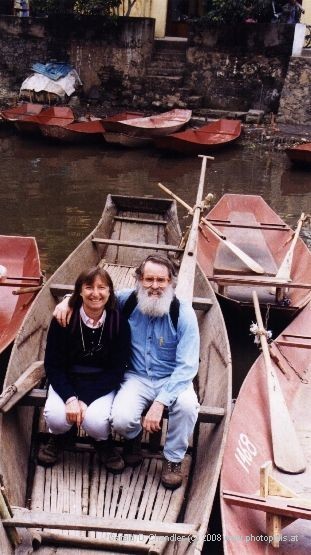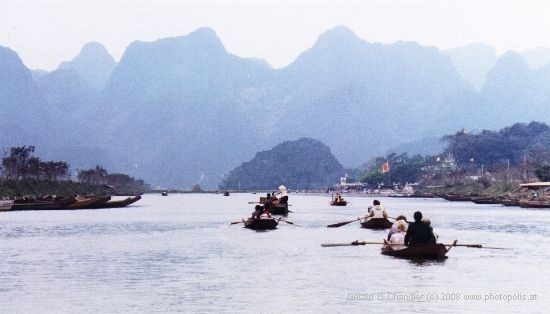Home | Front Page | Index | Blog | New | Contact | Site Map
Hanoi
Spring Festial
Perfume Pagoda
Sinh Cafe Tickets
Nha Trang Beach
Nha Trang - Hoi An Bus
Hoi An
Hue
Perfume River
Foto Show

Cambodia 2001
China 1999
China 2000
China 2001
Hong Kong 1999
Hong Kong 2000
Laos2001
Thailand 2000
Thailand 2001
The Perfume Pagoda is a cave that is located just off a delightful river. In Vietnamese the pagoda is called Chua Huong. Knowing the translation and a bit of Chinese we could recognize huong as being equivalent to Mandarin xiang and Cantonese heung, that became hong in English as in Hong Kong, which is usually translated as fragrant. Chua is translated as pagoda, but really should be temple, since there is usually not a tall octagonal building. Now we wondered what we’d see.
We usually don't take group tours but in Vietnam it is by far the easiest way to do things and it is very cheap. We’d bought our tickets to Chua Huong just the day before we went for $11 each. It would have been $10 without lunch. At our hotel ($30 per night) we’d arranged for breakfast at 6:00 so got ourselves up at 5:45. It was pretty difficult, but we did do it. A peek outside showed it to be still dark. Downstairs we had to rouse somebody to make breakfast, but they did it willingly. By 6:30 we were done with our self-made egg sandwiches but nobody had come seeking us. So we sat there reading, talking, and watching CNN. By about 7:00 we were a bit worried, so Gerry went to call Old Quarter Cafe, the backpacker-frequented agency that sold us our ticket. (For buying there we got a free hour of internet time and a free cold drink.) Gerry was told that the driver was late because of Tet but that in 5-10 minutes we would be picked up.
They were as good as their word. In five minutes a fellow came in to get us. To our surprise the Vietnamese guide, as he turned out to be, asked for us and talked to us in French. No problem, but a surprise and a taste of things to come. Out in the street was a 33-passenger bus, about half filled. The best (i.e. the front ) seats were taken. Those at the middle were very unsuitable for Gerry as they did not have enough leg room. So he took the last seat on the left rear. Jan took a window seat on the right middle.
We set off and it was soon clear to Gerry that we weren’t going there directly. To do so would have meant going south and more south to get out of town. But a few blocks after turning south we turned west and then north. And thus began a 35-minute tour of the town as we went to one budget hotel and travel cafe after another in the old quarter. By the time we were done the bus was exactly filled. Of course it must have been planned that way. When considering buying our tickets we wondered if each agency would have its own bus or if they would be consolidated; this seemed to prove consolidation. Later inquiries showed that everyone paid the same price even if they did buy from different shops.
By 8:00 we were truly going out of town. We headed west a bit and then turned south, following a wide boulevard that was too far from the center to be familiar to us; we'd spent the previous three days on foot and bicycle. Gradually, ever so gradually, the size and density of buildings decreased. Here and there was a large one that was a factory or government building, but mostly they were small shops, of the same low level prosperity and decayed look as we had seen elsewhere. Although it was early there were plenty of groups of three, four, and five sitting together on the sidewalk having a morning meal.
At last after 20-30 minutes it could safely be said that we were outside Hanoi and in the country. Then we passed through small towns/villages that were sometimes far apart and sometimes separated by short distances. Along the way there were numerous small temples that, if we’d been on our own, we would have stopped at. They had a familiar look to them, since they were like those to which we had bicycled but they were still different because they were countrifed, being more spacious, rambling, and among greenery or, less often, a few houses.
There were lots and lots of rice paddies, about equally divided between those with glistening water and those dry. The dry ones were covered with a dense crop of that wonderfully vibrant, almost neon, green color that new shoots have. Possibly they were the rice seedlings that would later be transplanted into the true, waterlogged paddies. Here and there in a way that added up to many, there were graves, that looked familiar because of what we’d seen in China: they are igloo like in size and structure but made of stone or concrete. Where an Eskimo might crawl in, is the place where the body might be made to enter the tomb.
About 6-10 times we saw more formal cemeteries, all following a pattern of their own: at the center a monument consisting of a vertical shaft of about 10 meters made of concrete and stone. Around it 50-200 tombstones in neat rows. All of this was enclosed by a low wall or fence. These cemeteries, unlike the individual traditional graves, were located in or adjacent to villages. It seems very likely that they are military cemeteries for those killed in the war. But that is a guess.
From within Hanoi mountains are not visible, although they are not too far from the city to the north. But our bus took us to the south and for the first hour of the ride we saw none. But then they began to appear and gradually became more distinct. Jan actually cried out when she saw them for the first time as they were quite a surprise. From photos we knew that we must be getting close; and from the amount of time we’d been travelling we concluded the same.

Departure Point |
At 9:30, after one and a half hour’s ride we came to a village and passed over a bridge. It was obvious that the bus had to turn left, but just before it did, from on the bridge, we got the sight we were waiting for: the river on which we would take a boat to the Perfume Pagoda stretched calmly into the distance, disappearing below the green hills and mountains, and dotted along it were modern (metal) versions of dugouts. Although seated far apart we called out to each other with delight: Look! The bus made its turn and stopped. The tour leader announced (in French) that we’d have a toilet break and then get into boats. Jan, as is her wont, made for the loos. Gerry went back to get a picture from the bridge. The town, village, or street, or whatever it should be called, is the antithesis of the serenity of the river. It is a mess, with dirt and noise about.
The toilets were down a narrow alley, with a 1.2 m high tiled wall forming adjacent "his” and "hers”. A tall man on one side could inadvertenly see a short woman stooping on the other. There was also a second "hers” down another little alley, but in spite of this, when Jan got down the first alley she found the ubiquitous queue. There is always a queue for the women’s loo! It was different from Chinese country loos, which are usually open troughs that one straddles with low (3-foot) partitions to form cubicles. This one was simply a roofless square cubicle with a drain in one corner. There were no "footprints” to stand on and nowhere to discard toilet paper and no flush. Outside there was a tap and a plastic pan that could be used to swill the floor. Primitive indeed, but still better than Nepal, which we learned later still offers open fields to its travellers as toilets!
After a ten-minute interval it was time to get on the boats. Gerry wanted a wooden boat rather than a metal one, feeling that is was more in the spirit of things, so he selected it and got in, sitting in the last of three rows. Jan sat to his left wishing we had had our own canoe to do the trip in. But then we would have missed the pleasure of getting to know our fellow passengers. Sometime after we set off we learned that our seat mate, to Jan’s left, was Francine and that her husband, Benoit, was seated on the bench in front of her. Both were French Quebecois. To his right was a French couple, from Bordeaux. Including the male and female Vietnamese guides everybody in the boat was French speaking.
We left expecting to settle down for a long ride, but in only ten minutes we pulled into the shore and were told to disembark. Gerry was amused because we could still see the place where we had boarded the boats. In fact, to the right of the river there was a dirt road; we could have walked up it in less time than it took to row us, as the distance was well under a kilometer. He wondered at first if that was the entire boat ride but happily soon found that it was not. It was hardly 10:00 a.m. yet; we had stopped so that we could visit the temple located just a few meters from the shore. We think this is called Huong Tich Chu (Pagoda of the Perfumed Vestige) but we may have gotten the names mixed up. We were given 30 minutes or so to wander around, which we did, also looking at the trinkets that the large number of vendors arranged around the temple were selling. As with all of the temples we have visited in Vietnam, it was more complex than at first appeared. There are always a number of halls and they are usually arranged in what seems a haphazard manner. They have to be discovered, one by one, by exploring every corner of the complex.
Sort of in back of the temple and farther along the river about 100 meters was another building; Gerry explored and found that it was a modern, or at least recently constructed public toilet. If we tourists had known and had been able to hold it in a while, our experiences might have been enhanced.
Our group gradually gathered and then the leader gave the signal to board and off we went again. While leaving the temple we read a sign that said on "January 6 of the lunar year” — which really means the sixth day of the first month in the lunar year — there is a traditional pilgrimage to the temple. Large crowds and a very fair-like atmosphere are the rule. To our regret we realized that the date referred to was only three days away and with different planning we might have seen this event. The reason for the mistranslation as "January 6” is interesting: Our western months were "imported” as "Month 1, Month 2,” etc. As Chinese and Vietnames translate from their language "Month 1” of the solar calendar into "January” they also translate "Month 1” of the lunar calendar into "January!”
This time the boat ride was much longer, more than an hour, through some absolutely lovely countryside but unfortunately under cloudy skies. The river was flanked some by marshes and some by rice paddies and then farther back, as backdrop, ranges of craggy dolomite-like mountains on either side, but these dolmites were not bare — instead they were covered in dense foliage. This is the stuff of Chinese paintings (of course we knew we were in Vietnam); now we knew they were not entirely the result of the artists’ imaginations. Looking both ahead and behind, the river was filled with boats. Many of them were, like ours, filled with tourists, but other, smaller ones, carried locals. Some of the locals had canoe-rafts piled hight with chairs, mats, and other paraphernalia that we later realized were for setting up vendor stalls near the temples. The coming festival would indeed have great crowds.
As noon approached and we were about half a kilometer away, a series of shoulder-to-shoulder tin-roofed, open-sided shacks came into view. This, obviously, would be our disembarcation point; what could these be but places to sell to tourists? When we got off the boat our guess was justified; the riverbank was lined with snack and souvenir stalls all hoping that we would buy some water, a soft drink, or a snack of some kind. Some of our fellow tourists did, though we didn’t. We made our way off the flat bottomed boat still a bit worried about ending in the water, although we were far enough up the flat, muddy bank that that was impossible. After a hundred meters or so we turned left away from the riverbank and up a short rise to a plateau area that again was filled with stalls. On one side were three or four much larger areas with restaurants installed, each advertising its wares with one or two stuffed animals. We did not find them much of an attraction.
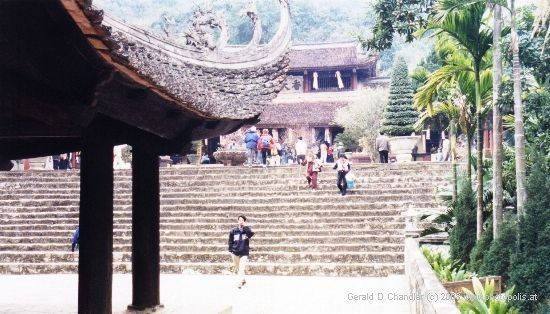
The Temple's Main Entrance |
We did not stop however, but carried on and up two very broad flights of stairs to the second temple of the day, Thien Chu (Pagoda Leading to Heaven; here thien is clearly related to Chinese tian, as in Tiananmen, Gate of Heavenly Peace). This was much bigger than the first, with a typical gatehouse halfway up the slope. Our French-speaking guide gave us a two-minute introduction to the place which included mentioning the fact that the temple had been bombed by the Americans during the Vietnam War. That got Gerry to wondering why on earth the Americans would bomb such an out of the way place. He concluded that either there was a suspected munitions store or anti-aircraft battery nearby that made the place a target.
After the brief intro, we all went our separate ways to climb to the different parts of the temple built against the slope of the hill. This was by far the largest temple complex that we had yet seen in Vietnam. Lying at the upper end of a narrow flat valley, with lush greenery on the slopes behind the buildings, the place impressed us. Truly something out of a movie; in fact, more and more we realize that movie makers often get their ideas from real life. As usual we shot far too many and yet far too few photographs.
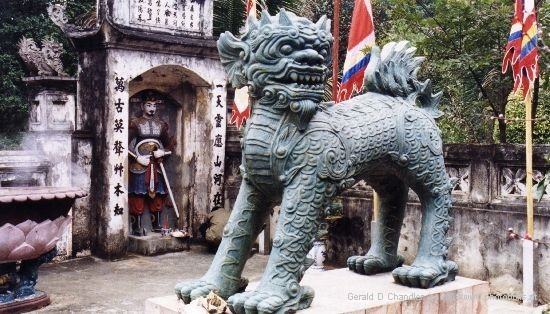
Temple Statuary |
At the prearranged time, about 12:30, we all gathered at the bottom of the temple steps and were ushered into one of the open-sided restaurant areas. Ours was one of the first ones we had noticed, and certainly the most interesting: like the others, it had two rows of tables, stretching back from its front about 20 meters. The tables and chairs are the now ubiquitous white plastic available for garden and porch furniture world wide. Along one edge was a counter with the cash register, some piles of softdrinks, and an assortment of prepared meats. But unlike the others, hanging outside, just near the cash register, were — well — meat. One hanging was a goat that had half of its rib cage gone and its testicles well exposed. Another was some animal, more like a deer than a goat, but neither, that was the product of a taxidermist. It was whole, if bloated.
There was some discussion at first, but eventually the guide accepted that lunch (but not soft drinks) had been pre-paid. We sat with the two other French-speaking couples and enjoyed a very good lunch of steamed rice, omelette, fried tofu, stir-fried vegetables, and a meat and vegetable dish. There was more than enough and it was served piping hot, a dish at a time.
After another loo-experience (one of the worst since India in 1978!) we walked back a bit uphill towards the temple we visited before lunch, but just before getting to it turned right, then left and started our climb to the Perfume Pagoda. The trail was similar in size and pitch to the path to Taishan, but unlike the latter it was paved with very uneven stones that were worn shiny by the feet of the visitors to the pagoda. Perhaps if we come again, we will find it replaced with the much more "finished” look of Taishan. Often both sides of the path were filled with vendor areas with a table in the center containing fruit, snacks, drinks or souvenirs and three sides of deep benches covered with straw mats. Rather annoyingling these vendor booths often obscure the view: they are made of bamboo poles covered with plastic tarpaulin in the standard Chinese red, blue, and white stripes. It was these tarpaulins at the downhill or outside of the path that usually kept us from seeing the green craggy hills and the river plain below.
The climb was steep, but steady, and not too long, taking the predicted 40 minutes including stops to strip off sweaters and so on. At the top of the last upward section was a gate, a much smaller version of the gates en route to Taishan. Passing through it we came face to face with a long long flight down of steep stairs. We descended them and then turned left and descended again toward what was obviously a cave. When we got to the bottom of the first flight and turned left, it still wasn’t obvious how big the cave was because it was too dark to make everything out at first. The cave had obviously been gouged out by water erosion and still contained stalactites and stalagmites that had been co-opted to serve as buddhist altars. It was the perfect place for a 50 meter Buddha, but that was not to be found.
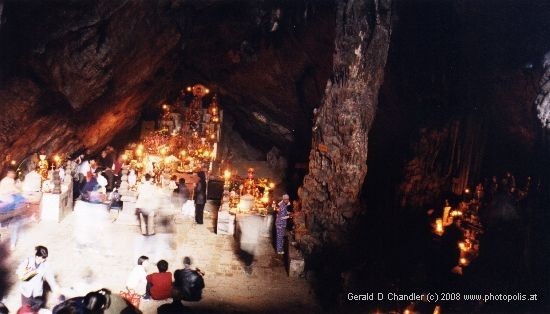
Looking down into the Cave |
The outer apron of the cave was again filled with vendors selling incense sticks, souvenir good-luck charms, fruit snacks, postcards and what have you. Only after walking beyond them did we see the altars deep in the cave. As usual in Vietnam, the idols are arranged in tiers one behind the other. The tiers are also filled with offerings of one kind and another. The only light was from candles placed here and there on the altar. It took some time to adjust the eyes enough to see the limits of the cave.
Still inside, Gerry bought a watermelon segment to refresh us and snapped up a good-luck charm too to prove that he had been here and we set off up to the entrance gate and then down the steps back to the restaurant, deliberately going slowly to catch the views that we had missed on the way up. The watermelon was asked at D5000 (35 cents) and bought at D3000 (20 cents). The charm, in the shape of a 3-segment gong or anvil, was the largest available of a lot of similar designs. On one side it said Chuc Mung Nam Moi (happy new year). It too cost D3000, after bargaining.
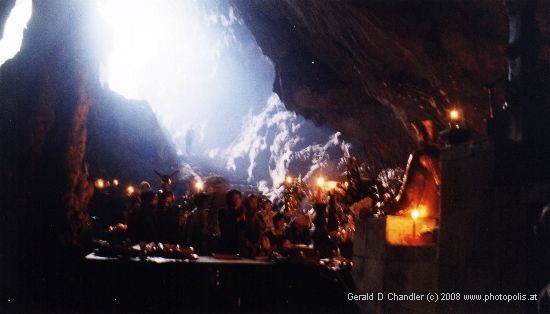
Worshippers before the Buddha |
Then we reversed course: out of the cave, down the hill, a stop at our restaurant for a drink and then down to the river. Just before we got to our boat, Gerry saw a wonderful sight to behold: fresh bread being taken out of the oven. We’d seen these very European looking loaves often in Vietnam — they are about 15 cm long, shaped approximately like an American football or mini-submarine, and have a wonderful looking (are we homesick or aren't we?) crust. Gerry immediately bought one fresh from the oven, so hot he couldn’t hold it but still managed to split it in two, and we both munched it with great pleasure, taking care not to burn our fingers.
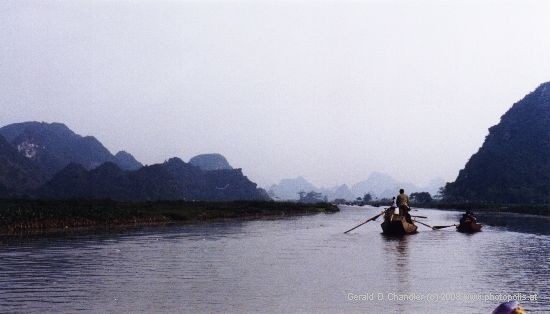
Paddling back to our bus |
Late in the afternoon we set off. The boat trip back was, if anything, even better than the inbound trip. The day had warmed up and as we glided along, the sun came out bringing the whole place alive. We even saw a lovely kingfisher sitting on the river bank and then in a flash of iridescent blue fly away. The sun low over the mountains as it was near setting and again gave this view of layer upon layer fading away in the distance. During the voyage we spent a lot of time sharing experience with our fellow French voyagers. Like us they are retired or taking time off. Francine and Benoit have been on the road since September and will continue until April. Among their interesting experiences so far are 10 days trekking around Annapurna in Nepal and ten days in a retreat at Dharamsala where they kept a vow of silence while they studied buddhism. The other couple, whose names we never learned, are from Bordeaux. He’s a retired 66-year old high school mathematics teacher, she a retired primary school teacher; they make a two or three month trip every year. Will we be doing that ten years from now?
The drive back was uneventful. Jan watched avidly until it became too dark to see about half-way back, noticing lots and lots of things she would have liked to visit or photograph and thinking we should rent a motorbike and come back to do just that. Gerry spoke with his seat neighbor; a 30-ish German. He had come to Vietnam in 1992 when it was newly opened to tourists and again in 1993. In one year he went from being a great curiousity in Hanoi to being nearly ordinary. This was his third trip to the Perfumed Pagoda, he liked it so much. He’s a computer programmer in Frankfurt, working on control systems for Alstrom. Every year at this time he takes off seven weeks and travels with a varying group of buddies. This year they started in Bangkok, travelled overland through Thailand and Laos to China, and then after a few weeks took the train to Hanoi. Now it was too cold for them and they wanted to get back to Bangkok as quickly as possible.
